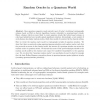36 search results - page 7 / 8 » Cascade Encryption Revisited |
IACR
2011
12 years 7 months ago
2011
The hardware-attractive block cipher family KTANTAN was studied by Bogdanov and Rechberger who identified flaws in the key schedule and gave a meet-in-the-middle attack. We revis...
EUROCRYPT
2009
Springer
14 years 8 months ago
2009
Springer
A group key agreement (GKA) protocol allows a set of users to establish a common secret via open networks. Observing that a major goal of GKAs for most applications is to establish...
PKC
2010
Springer
13 years 9 months ago
2010
Springer
Encrypt-and-sign, where one encrypts and signs a message in parallel, is usually not recommended for confidential message transmission. The reason is that the signature typically l...
CORR
2010
Springer
13 years 7 months ago
2010
Springer
Once quantum computers reach maturity most of today's traditional cryptographic schemes based on RSA or discrete logarithms become vulnerable to quantum-based attacks. Hence, ...
TIT
2010
13 years 2 months ago
2010
This paper considers the construction and analysis of pseudo-random functions (PRFs) with specific reference to modes of operations of a block cipher. In the context of message aut...

